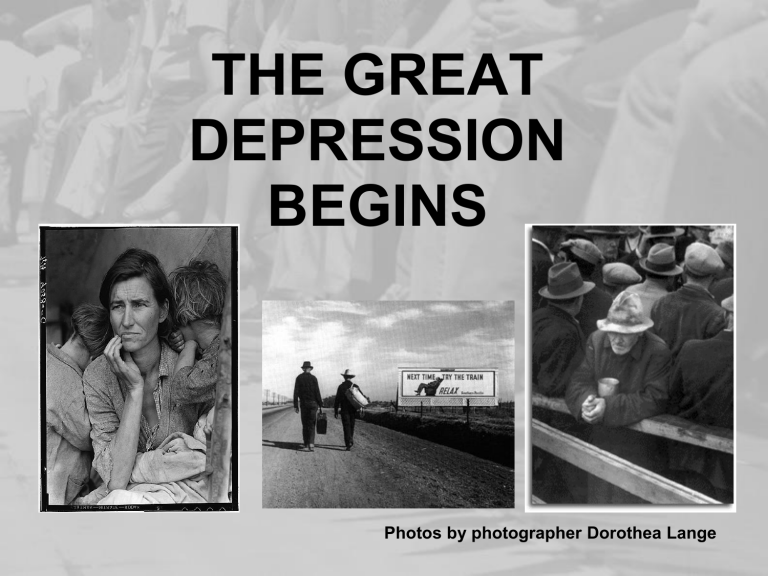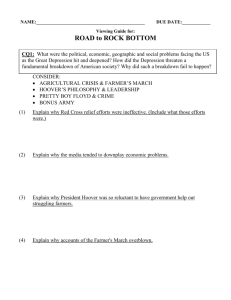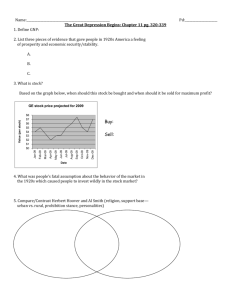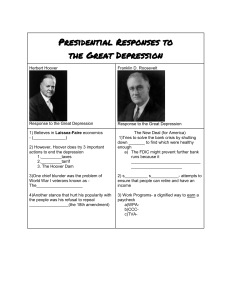
THE GREAT DEPRESSION BEGINS Photos by photographer Dorothea Lange SECTION 1: THE NATION’S SICK ECONOMY As the 1920s advanced, serious problems threatened the economy while Important industries struggled, including: • • • • • • • • • Agriculture Railroads Textiles Steel Mining Lumber Automobiles Housing Consumer goods FARMERS STRUGGLE Photo by Dorothea Lange CONSUMER SPENDING DOWN • By the late 1920s, American consumers were buying less • Rising prices, stagnant wages and overbuying on credit were to blame • Most people did not have the money to buy the flood of goods factories produced GAP BETWEEN RICH & POOR Photo by Dorothea Lange HOOVER WINS 1928 ELECTION • Republican Herbert Hoover ran against Democrat Alfred E. Smith in the 1928 election • Hoover emphasized years of prosperity under Republican administrations • Hoover won an overwhelming victory Young Hoover supporter in 1928 THE STOCK MARKET STOCK PRICES RISE THROUGH THE 1920s • Through most of the 1920s, stock prices rose steadily • The Dow reached a high in 1929 of 381 points (300 points higher than 1924) • By 1929, 4 million Americans owned stocks New York Stock Exchange SEEDS OF TROUBLE • By the late 1920s, problems with the economy emerged • Speculation: Too many Americans were engaged in speculation – buying stocks & bonds hoping for a quick profit • Margin: Americans were buying “on margin” – paying a small percentage of a stock’s price as a down payment and borrowing the rest The Stock Market’s bubble was about to break THE 1929 CRASH • In September the Stock Market had some unusual up & down movements • On October 24, the market took a plunge . . .the worst was yet to come • On October 29, now known as Black Tuesday, the bottom fell out • 16.4 million shares were sold that day – prices plummeted • People who had bought on margin (credit) were stuck with huge debts By mid-November, investors had lost about $30 billion THE GREAT DEPRESSION Alabama family, 1938 Photo by Walter Evans • The Stock Market crash signaled the beginning of the Great Depression • The Great Depression is generally defined as the period from 1929 – 1940 in which the economy plummeted and unemployment skyrocketed • The crash alone did not cause the Great Depression, but it hastened its arrival CAUSES OF THE GREAT DEPRESSION • Tariffs & war debt policies • U.S. demand low, despite factories producing more • Farm sector crisis • Easy credit • Unequal distribution of income FINANCIAL COLLAPSE • After the crash, many Americans panicked and withdrew their money from banks • Banks had invested in the Stock Market and lost money • In 1929- 600 banks fail • By 1933 – 11,000 of the 25,000 banks nationwide had collapsed GNP DROPS, UNEMPLOYMENT SOARS • Between 1928-1932, the U.S. Gross National Product (GNP) – the total output of a nation’s goods & services – fell nearly 50% from $104 billion to $59 billion • 90,000 businesses went bankrupt • Unemployment leaped from 3% in 1929 to 25% in 1933 • The U.S. was not the only country gripped by the Great Depression • Much of Europe suffered throughout the 1920s • In 1930, Congress passed the toughest tariff in U.S. history called the HawleySmoot Tariff • It was meant to protect U.S. industry yet had the opposite effect • Other countries enacted their own tariffs and soon world trade fell 40% HAWLEYSMOOT TARIFF SECTION 2: HARDSHIPS DURING DEPRESSION • The Great Depression brought hardship, homelessness, and hunger to millions • Across the country, people lost their jobs, and their homes • Some built makeshifts shacks out of scrap material • Before long whole shantytowns (sometimes called Hoovervilles in mock reference to the president) sprung up THE DUST BOWL • A severe drought gripped the Great Plains in the early 1930s • Wind scattered the topsoil, exposing sand and grit • The resulting dust traveled hundreds of miles • One storm in 1934 picked up millions of tons of dust from the Plains an carried it to the East Coast Kansas Farmer, 1933 Dust storm approaching Stratford, Texas - 1934 Dust buried cars and wagons in South Dakota in 1936 Storm approaching Elkhart, Kansas in 1937 HARDEST HIT REGIONS Boy covers his mouth to avoid dust, 1935 Photographer Dorothea Lange captures a family headed west to escape the dust storms SECTION 3: HOOVER STRUGGLES WITH THE DEPRESSION • After the stock market crash, President Hoover tried to reassure Americans • He said, “Any lack of confidence in the economic future . . . Is foolish” • He recommended business as usual HOOVER TAKES ACTION: TOO LITTLE TOO LATE • Hoover gradually softened his position on government intervention in the economy • He created the Federal Farm Board to help farmers • He also created the National Credit Organization that helped smaller banks • His Federal Home Loan Bank Act and Reconstruction Finance Corp were two measures enacted to protect people’s homes and businesses BONUS ARMY • A 1932 incident further damaged Hoover’s image • That spring about 15,000 World War I vets arrived in Washington to support a proposed bill • The Patman Bill would have authorized Congress to pay a bonus to WWI vets immediately • The bonus was scheduled to be paid in 1945 --- The Army vets wanted it NOW BONUS ARMY TURNED DOWN • Hoover called the Bonus marchers, “Communists and criminals” • On June 17, 1932 the Senate voted down the Putnam Bill BONUS MARCHERS CLASH WITH SOLDIERS • Hoover told the Bonus marchers to go home– most did • 2,000 refused to leave • Hoover sent a force of 1,000 soldiers under the command of General Douglas MacArthur and his aide Dwight Eisenhower AMERICANS SHOCKED AT TREATMENT OF WWI VETS • • • MacArthur’s 12th infantry gassed more than 1,000 marchers, including an 11-month old baby who died Two vets were shot and many were injured Americans were outraged and once again, Hoover’s image suffered Hoover had little chance to be re-elected in 1932



